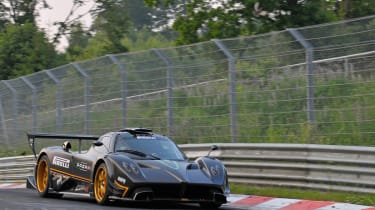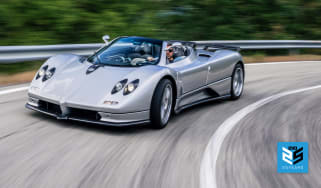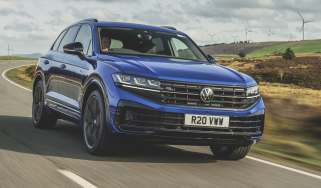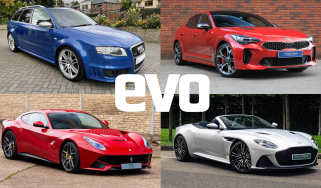Pagani Zonda R Nürburgring record
When Horacio Pagani took his 739bhp Zonda R track car to the Nürburgring to challenge a lap record set by Ferrari, things didn't go entirely to plan.
You will probably have read the headlines, you might even have seen Clarkson & Co talking about it on Top Gear. The Pagani Zonda R recently set a new lap record for a production-derived sports car around the Nürburgring’s Nordschleife. The time? 6min 47sec. Undeniably impressive. But numbers can be so dry. They say nothing of the trials and tribulations, the heartache and the late nights that led up to and went into that record-breaking run. Once you know, 6min 47sec means so much more.
Rewind four hours from Horacio Pagani’s moment of solitary contemplation captured on the previous pages. It’s a warm evening and the last few Touristenfahrten laps are being run. The 739bhp, track-only Zonda R is parked up in the old pitlane usually reserved for manufacturer test cars and secret prototypes. Lots of people are moving around the car, checking, fettling and checking again. I walk over to say hello to Marc Basseng, Ring specialist and the pilot for the record attempt. He’s much more quietly spoken than you might imagine, his handshake firm without threatening to crush your knuckles the way so many other race drivers do.
I ask him what he thinks the most limiting factor for the Zonda will be. ‘The tyres,’ he says immediately, and I instinctively glance at the Pirelli rubber that’s painted around the golden 19-inch rims. ‘They’re too thin – you want 18- inch wheels and deeper sidewalls. I think these might puncture too easily, but we will see.’
What did Basseng think of Ferrari test driver Raffaele de Simone’s 6min 58sec lap in the 599XX track car earlier this year? ‘It was a good lap,’ he replies. ‘He was a good driver.’
There’s a pause while we watch the hive of activity around the R. The car almost looks too good to drive, and although I know the inherent strength of carbonfibre, it nonetheless looks worryingly fragile when its thin form is worked with such intricate delicacy. You wouldn’t play cricket with a Fabergé egg, yet this Zonda is about to be subjected to the most brutal racetrack in the world.
Quite suddenly Basseng asks, ‘What time did the Radical do round here?’ He’s referring to the road-car record set by a Radical SR8 last year.
‘6.48,’ I say. He smiles and rubs his hands.
Half an hour later, Basseng unhooks the steering wheel from where it hangs in the Zonda’s roof, plugs it into the splines on the steering column and heads out onto the Nordschleife. At the same time, I drive back to the road and head in the opposite direction, through Nürburg to the public car park, to wait for the flypast on the endless Döttinger-Höhe straight at the end of the lap. When it arrives it’s extraordinary; one long, lone note, shrieking its way towards you in a crescendo you can almost feel, until it rattles the beer glasses of the tourists lingering on the balcony of the restaurant. The wail then tails off towards what must be a heart-pounding flat left turn under the bridge at Tiergarten.
Eardrums still tingling, I jump back in the car and head towards Galgenkopf, the long right-hander that leads onto the straight. I have to run alongside the track to get to the viewing area before the car comes round again, but I know I’m in time. You can hear the R from miles away, approaching through the terrifying roller-coaster apices of Pflanzgarten before it eventually bursts into view out of the Mini Karussell, looking lower and more than ever like an automotive stealth bomber. You can see the car working the limits of its grip as it dives into the corner, the huge front splitter bottoming out briefly. Then it’s gone and the waiting resumes.
The silence lasts longer this time. Seven minutes. Eight, nine, ten. Something’s wrong. After 20 minutes I head back to the old pits. Thankfully it looks like it was nothing serious, because Marc is smiling and relaxed, chatting to everyone. Probably just an electrical fault…
‘Kesselchen at about 260kph [162mph] the car goes…’ Marc drops his left shoulder to intimate a sudden sagging at the left-rear and raises his hands with an imaginary steering wheel to show the front-right rising. He then mimes adding what must be all of the available opposite lock. ‘At first I was thinking maybe I touched the kerb a little bit,’ he continues, ‘and in the next left-hander everything was OK. Then in the next right-hander it happens again and I said, no, something is definitely wrong, and I stopped the car. At first I was looking to see if there was a puncture, but it was something with the rear suspension. I don’t know if it broke or what.’
So, just to recap, you had a rear suspension failure in a corner at over 160mph?
‘Yes,’ he says, still beaming like he’s just found twenty euros in his overalls.
Right. Um… how was the car up to that point?
‘The car is good for the grip, the downforce is amazing, but sometimes it gets air under the car so it lifts the nose. The brakes are shit, really shit! The feeling and the brake performance is not so nice, but maybe we have to bleed the system again, maybe there is still some air in it because the road car has the same brakes and we never have something like that. So we will see.’
Did you change anything in the set-up after the first lap?
‘No, the car is fine. Slight understeer but the rear is really solid. Perfect, like I was expecting it. I really enjoyed the second lap and I wanted to set a time, but then that happened. Ah well. We’ll come back tomorrow morning.’
Except it looks like they won’t be coming back tomorrow morning. An hour later, down at Pirelli’s huge workshops on the Nürburgring’s industrial estate, the rear of the Zonda R is laid bare, like the back removed from a watch to expose the beautifully complicated movement. Under the fluorescent lights the R’s jewel-like inner workings are exposed and ready for surgery but, as night falls outside, the prognosis isn’t good. Just ahead of the upper wishbone one of the hollow beams of the rear subframe appears to have been torn open. Apparently it failed as the car hit a compression halfway through the corner, overloading the already loaded chassis. This is why people test at the Nürburgring – it puts cars in situations and under stresses that nowhere else does.
No one is running around. There is no frantic F1-style activity as mechanics limber up for a long night of repair work. There is just silence as the small, professorial figure of Horacio Pagani ponders his stricken machine. This could be terminal. And then something happens that actually makes me laugh. Very quietly, with just the slow squeaking of tyres turning on a shiny floor, they wheel in another Zonda R.
The following day, sponsor-decaled body panels are switched from the broken factory hack to the loaned customer car as it’s readied for action in the evening session. A fix also needs to be administered to the seemingly vulnerable section of tubing, so small pieces of metal have been fashioned to act as tiny bracing buttresses. They need to be attached to the subframe, but as the welder pulls down his mask I’m not sure whether he’s doing so to shield his eyes from the retina-damaging white light of the electric arc or to shelter him from the unblinking stare of Horacio.
By six o’clock in the evening the second Zonda looks like the first Zonda and is being loaded onto the truck to make the short journey to the Nordschleife. The fact that the R, like the 599XX, can’t be driven to the track means that some people will question the point of setting a lap time. But then what better way is there for us to gauge these cars, and for their makers to demonstrate their engineering prowess, than by seeing how they stack up against the toughest one-lap litmus test of them all?
The lack of a tax disc doesn’t diminish the nerve and skill required to extract the lap time. Basseng has decided to go straight out this time. No practice runs, no shakedowns, just helmet on and go for the record. This seems very brave given that he will be in a new and untested version of the very car that tried to dispatch him into the scenery the previous evening.
The attempt will start from the public car park this time – and the key word there is public. It’s the end of the tourist session so crowds of oohing and ahhing petrolheads wander away from their Ring-stickered pride and joys and gather to gawp as the back of the truck opens. I imagine it’s the same sort of awed surprise that would greet Eric Clapton turning up to a local Tuesday evening open mic session.
After a while I leave and head round to Pflanzgarten One to watch. There was thunder amongst the Eifel mountains earlier in the day and for a while it looked like rain might spoil any attempt, but it’s now a beautifully still evening, air temperature warm without being enervating, and the Green Hell is at its most lush. I’m actually nervous as I wait for the surface-skimming shriek. I know the data from the previous day was fantastic, and greedily I really want to witness something historic. I’m not disappointed. It’s often said that a quick driver will make a fast lap look almost easy and undramatic, but there is no way to make an airborne Zonda look unspectacular.
As I drive back into the public car park, the first thing I see is a smiling Horacio Pagani with his record-breaking creation. 6min and 47sec. Mission accomplished.
What constitutes a ring record?
The Nürburgring Nordschleife lap record is a thorny, worm-filled can of an issue. The very notion of a benchmark time there first came to the motoring world’s attention in 1996 with Dirk Schoysman’s 7min 59sec lap in a Nissan GT-R R33 V-Spec. Since then there have been numerous records claimed, but what constitutes a valid lap time is tricky to pin down.
First up is the circuit itself, because believe it or not, not all claimed records are set over its entire length. The complete lap (as run by the Zonda R) is 20.832km, but many of the times from industry pool sessions are set over 20.600km due to the need to drive slowly past the old pits. If a time is set during a public session (not to be recommended) then it will be a ‘bridge to gantry’ time that misses out about 30 seconds of the main Döttinger-Höhe straight.
There is also the issue of which cars should be compared to which. The outright record is easy: it’s Stefan Bellof’s 6min 11sec lap in a Porsche 956 Group C car, set during qualifying for the 1983 1000km Sportscar race. The ‘production-derived sports car’ record claimed by the Zonda R is a newcomer, established by Ferrari with its 599XX. However, it’s the road-car record that creates controversy, because it seems no one can agree on just what constitutes a road car.
Strictly speaking, it should be a standard production car, so no special springs and dampers or engine mods, and the tyres should be road-legal too. The Radical SR8 LM that went round in 6min 48sec last year did so on the same tyres it drove to and from the circuit on, yet some would say that a Radical is too specialised to be classed as a road car.
So, should there be a minimum production run of, say, 500 to qualify? This would rule out many of our favourite supercars and by our reckoning would leave the Corvette ZR1 as the record holder with a lap of 7min 26.4sec. Porsche’s GT2 RS could take this title, but it has yet to sell enough cars or have its 7min 18sec lap independently verified.
What do we think? Well, given that our own lap record leader board for the Bedford Autodrome’s West Circuit has a Radical at the top, I think you can guess the answer.
Specifications
| Engine | V12, 5987cc, dohc per bank, four valves per cylinder |
| Max power | 739bhp @ 7500rpm |
| Max torque | 524lb ft @ 5700rpm |
| Top speed | 233mph (claimed) |
| 0-62mph | 3.0sec (claimed) |
| Price | c£1,456,000 (2009) |
| On sale | Sold out |





